Channel Shape Effects on Device Instability of Amorphous Indium–Gallium–Zinc Oxide Thin Film Transistors
Abstract
:1. Introduction
2. Materials and Methods
3. Results and Discussion
3.1. S/D Asymmetry Effects for 3-Types a-IGZO TFTs
3.2. Bias Temperature Stress Instability of 3-Types a-IGZO TFTs
3.3. Study on E-Field Distribution in the Channel Depending on Channel Shape
4. Conclusions
Author Contributions
Funding
Conflicts of Interest
References
- Chhowalla, M.; Jena, D.; Zhang, H. Two-dimensional semiconductors for transistors. Nat. Rev. Mater. 2016, 1, 16052. [Google Scholar] [CrossRef]
- Park, J.S.; Maeng, W.-J.; Kim, H.-S.; Park, J.-S. Review of recent developments in amorphous oxide semiconductor thin-film transistor devices. Thin Solid Films 2012, 520, 1679–1693. [Google Scholar] [CrossRef]
- Prakash, P.; Sundaram, K.M.; Bennet, M.A. A review on carbon nanotube field effect transistors (CNTFETs) for ultra-low power applications. Renew. Sustain. Energy Rev. 2018, 89, 194–203. [Google Scholar] [CrossRef]
- Nomura, K.; Ohta, H.; Takagi, A.; Kamiya, T.; Hirano, M.; Hosono, H. Room-temperature fabrication of transparent flexible thin-film transistors using amorphous oxide semiconductors. Nat. Cell Biol. 2004, 432, 488–492. [Google Scholar] [CrossRef] [PubMed]
- Fortunato, E.; Barquinha, P.; Martins, R. Oxide Semiconductor Thin-Film Transistors: A Review of Recent Advances. Adv. Mater. 2012, 24, 2945–2986. [Google Scholar] [CrossRef] [PubMed]
- Liu, Y.; Zhou, H.; Cheng, R.; Yu, W.; Huang, Y.; Duan, X. Highly Flexible Electronics from Scalable Vertical Thin Film Transistors. Nano Lett. 2014, 14, 1413–1418. [Google Scholar] [CrossRef] [PubMed]
- Jeong, J.K.; Jeong, J.H.; Choi, J.H.; Im, J.S.; Kim, S.H.; Yang, H.W.; Kang, K.N.; Kim, K.S.; Ahn, T.K.; Chung, H.; et al. 3.1: Distinguished Paper: 12.1-Inch WXGA AMOLED Display Driven by Indium-Gallium-Zinc Oxide TFTs Array. SID Symp. Dig. Tech. Pap. 2008, 39, 1–4. [Google Scholar] [CrossRef]
- Chuang, C.-S.; Fung, T.-C.; Mullins, B.G.; Nomura, K.; Kamiya, T.; Shieh, H.-P.D.; Hosono, H.; Kanicki, J. P-13: Photosensitivity of Amorphous IGZO TFTs for Active-Matrix Flat-Panel Displays. SID Symp. Dig. Tech. Pap. 2008, 39, 1215–1218. [Google Scholar] [CrossRef] [Green Version]
- Kim, J.I.; Cho, I.-T.; Jeong, C.-Y.; Lee, D.; Kwon, H.-I.; Jung, K.D.; Park, M.S.; Seo, M.S.; Kim, T.Y.; Lee, J.H.; et al. Local-Degradation-Induced Threshold Voltage Shift in Turned-OFF Amorphous InGaZnO Thin Film Transistors Under AC Drain Bias Stress. IEEE Electron Device Lett. 2015, 36, 579–581. [Google Scholar] [CrossRef]
- Hsieh, T.Y.; Chang, T.C.; Chen, T.C.; Tsai, M.Y.; Chen, Y.T.; Jian, F.Y. Investigating degradation behavior of InGaZnO thin-film transistors induced by charge-trapping effect under DC and AC gate bias stress. ECS Trans. 2012, 45, 133–140. [Google Scholar] [CrossRef]
- Lee, S.; Jeon, K.; Park, J.-H.; Kim, S.; Kong, D.; Kim, D.M.; Kim, D.H.; Kim, S.; Kim, S.; Hur, J.; et al. Electrical stress-induced instability of amorphous indium-gallium-zinc oxide thin-film transistors under bipolar ac stress. Appl. Phys. Lett. 2009, 95, 132101. [Google Scholar] [CrossRef]
- Hsieh, T.-Y.; Chang, T.-C.; Chen, T.-C.; Tsai, M.-Y.; Chen, Y.-T.; Chung, Y.-C.; Ting, H.-C.; Chen, C.-Y. Origin of self-heating effect induced asymmetrical degradation behavior in InGaZnO thin-film transistors. Appl. Phys. Lett. 2012, 100, 232101. [Google Scholar] [CrossRef]
- Chen, T.-C.; Chang, T.-C.; Tsai, C.-T.; Hsieh, T.-Y.; Chen, S.-C.; Lin, C.-S.; Hung, M.-C.; Tu, C.-H.; Chang, T.-C.; Chen, P.-L. Behaviors of InGaZnO thin film transistor under illuminated positive gate-bias stress. Appl. Phys. Lett. 2010, 97, 112104. [Google Scholar] [CrossRef]
- Chang, Y.-G.; Moon, T.-W.; Kim, D.H.; Lee, H.S.; Kim, J.H.; Park, K.-S.; Kim, C.-D.; Im, S. DC Versus Pulse-Type Negative Bias Stress Effects on the Instability of Amorphous InGaZnO Transistors Under Light Illumination. IEEE Electron Device Lett. 2011, 32, 1704–1706. [Google Scholar] [CrossRef]
- Lee, H.; Liu, C.H.; Kanicki, J. Asymmetric electrical properties of half corbino hydrogenated amorphous silicon thin-film transistor and its applications to flat panel displays. Jpn. J. Appl. Phys. 2011, 50, 074203. [Google Scholar] [CrossRef]
- Bianchi, R.F.; Onmori, R.K.; Faria, R.M. Device model for poly(o-methoxyaniline) field-effect transistor. J. Polym. Sci. Part B Polym. Phys. 2004, 43, 74–78. [Google Scholar] [CrossRef]
- Matsuki, N.; Abiko, Y.; Miyazaki, K.; Kobayashi, M.; Fujioka, H.; Koinuma, H. Concept and performance of a field-effect amorphous silicon solar cell. Semicond. Sci. Technol. 2003, 19, 61–64. [Google Scholar] [CrossRef]
- Lee, H.; Yoo, J.-S.; Kim, C.-D.; Chung, I.-J.; Kanicki, J. Asymmetric Electrical Properties of Corbino a-Si:H TFT and Concepts of Its Application to Flat Panel Displays. IEEE Trans. Electron. Devices 2007, 54, 654–662. [Google Scholar] [CrossRef]
- Byun, Y.H.; Boer, W.D.; Yang, M.; Gu, T. An amorphous silicon TFT with annular-shaped channel and reduced gate-source capacitance. IEEE Trans. Electron. Devices 1996, 43, 839–841. [Google Scholar] [CrossRef]
- Munteanu, D. Circular Pseudo-Metal Oxide Semiconductor Field Effect Transistor in Silicon-on-Insulator Analytical Model, Simulation, and Measurements. Electrochem. Solid-State Lett. 1999, 2, 242. [Google Scholar] [CrossRef]
- Wakai, H.; Yamamura, N.; Sato, S.; Kanbara, M. Hin Film Transistor. U.S. Patent 5055899, 2 April 1991. [Google Scholar]
- Lee, J.; Huh, J.; Kim, D. Thin Film Transistors for Liquid Crystal Displays. U.S. Patent 6274884, 14 August 2001. [Google Scholar]
- Lee, H.; Yoo, G.; Yoo, J.-S.; Kanicki, J. Asymmetric electrical properties of fork a-Si:H thin-film transistor and its application to flat panel displays. J. Appl. Phys. 2009, 105, 124522. [Google Scholar] [CrossRef] [Green Version]
- Choi, S.; Choi, S.-J.; Kim, D.H.; Park, S.; Kim, J.; Seo, Y.; Shin, H.J.; Jeong, Y.S.; Bae, J.U.; Oh, C.H.; et al. Positive Bias Stress Instability of InGaZnO TFTs With Self-Aligned Top-Gate Structure in the Threshold-Voltage Compensated Pixel. IEEE Electron. Device Lett. 2019, 41, 50–53. [Google Scholar] [CrossRef]
- Lee, J.M.; Cho, I.-T.; Lee, J.-H.; Kwon, H.-I. Bias-stress-induced stretched-exponential time dependence of threshold voltage shift in InGaZnO thin film transistors. Appl. Phys. Lett. 2008, 93, 093504. [Google Scholar] [CrossRef]
- Suresh, A.; Muth, J.F. Bias stress stability of indium gallium zinc oxide channel based transparent thin film transistors. Appl. Phys. Lett. 2008, 92, 033502. [Google Scholar] [CrossRef] [Green Version]
- Cho, E.N.; Kang, J.H.; Yun, I. Effects of channel thickness variation on bias stress instability of InGaZnO thin-film transistors. Microelectron. Reliab. 2011, 51, 1792–1795. [Google Scholar] [CrossRef]
- Chen, T.; Chang, T.-C.; Hsieh, T.; Tsai, C.; Chen, S.; Lin, C.; Jian, F.; Tsai, M.-Y. Investigation of the gate-bias induced instability for InGaZnO TFTs under dark and light illumination. Thin Solid Films 2011, 520, 1422–1426. [Google Scholar] [CrossRef]
- Mudgal, T.; Edwards, N.; Ganesh, P.; Bharadwaj, A.; Powell, E.; Pierce, M.S.; Manley, R.G.; Hirschman, K.D. Investigation on the Gate Electrode Configuration of IGZO TFTs for Improved Channel Control and Suppression of Bias-Stress Induced Instability. ECS Trans. 2016, 75, 189–197. [Google Scholar] [CrossRef]
- Zhou, Y.; Dong, C. Influence of Passivation Layers on Positive Gate Bias-Stress Stability of Amorphous InGaZnO Thin-Film Transistors. Micromachines 2018, 9, 603. [Google Scholar] [CrossRef] [Green Version]
- Zhou, X.; Zhang, X.; Shao, Y.; Zhang, L.; Shengdong, Z.; Han, D.; Wang, Y.; Zhang, S. P-6.1: Asymmetric Effects of Gate-Bias Stress Voltage on the Stability under Positive and Negative Gate-Bias Stress of a-IGZO TFTs. SID Symp. Dig. Tech. Pap. 2018, 49, 597–600. [Google Scholar] [CrossRef]
- Rhee, J.; Choi, S.; Kang, H.; Kim, J.-Y.; Ko, D.; Ahn, G.; Jung, H.; Choi, S.-J.; Kim, D.M.; Kim, D.H. The electron trap parameter extraction-based investigation of the relationship between charge trapping and activation energy in IGZO TFTs under positive bias temperature stress. Solid-State Electron. 2018, 140, 90–95. [Google Scholar] [CrossRef]
- Libsch, F.R.; Kanicki, J. Bias-Stress-Induced Stretched-Exponential Time Dependence of Charge Injection and Trapping in Amorphous Silicon Thin-Film Transistors. Appl. Phys. Lett. 1993, 62, 1286–1288. [Google Scholar] [CrossRef]
- Domínguez, M.A.; Rosales, P.; Torres, A.; Flores, F.; Luna, J.A.; Alcantara, S.; Moreno, M. Impact of planarized gate electrode in bottom-gate thin-film transistors. Rev. Mex. Fis. 2016, 62, 223–228. [Google Scholar]

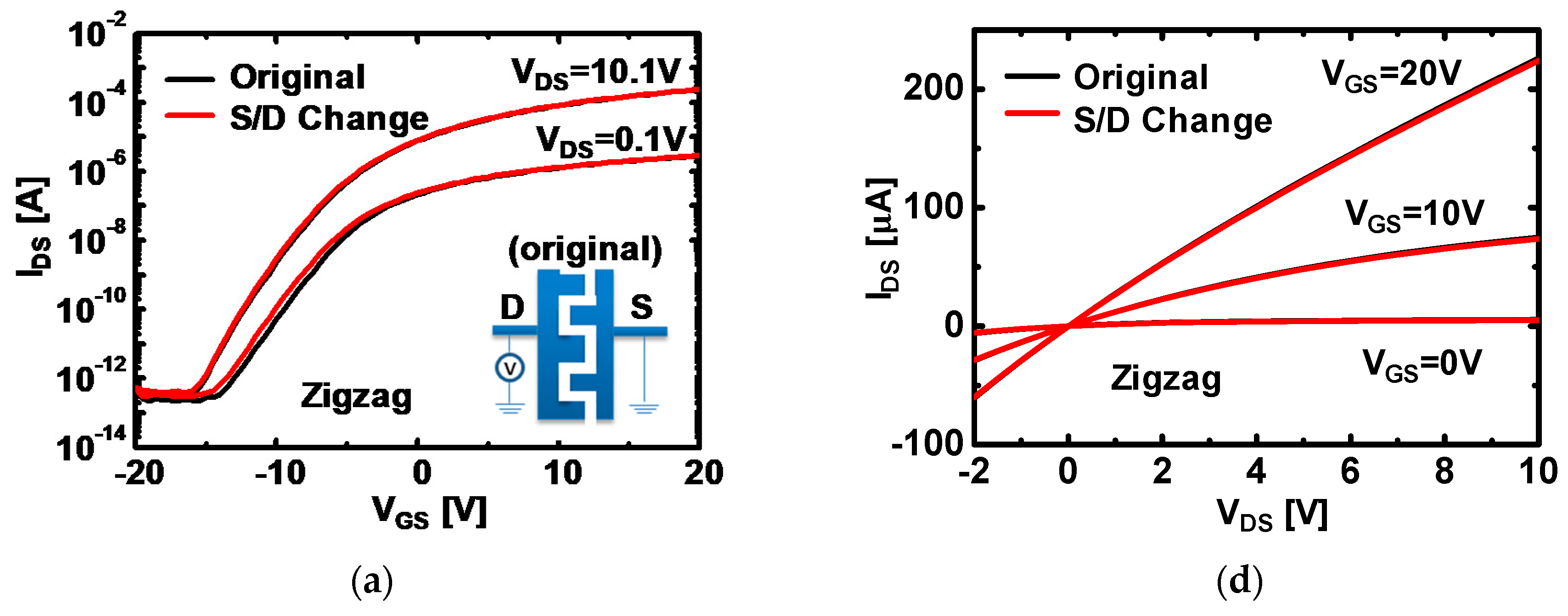



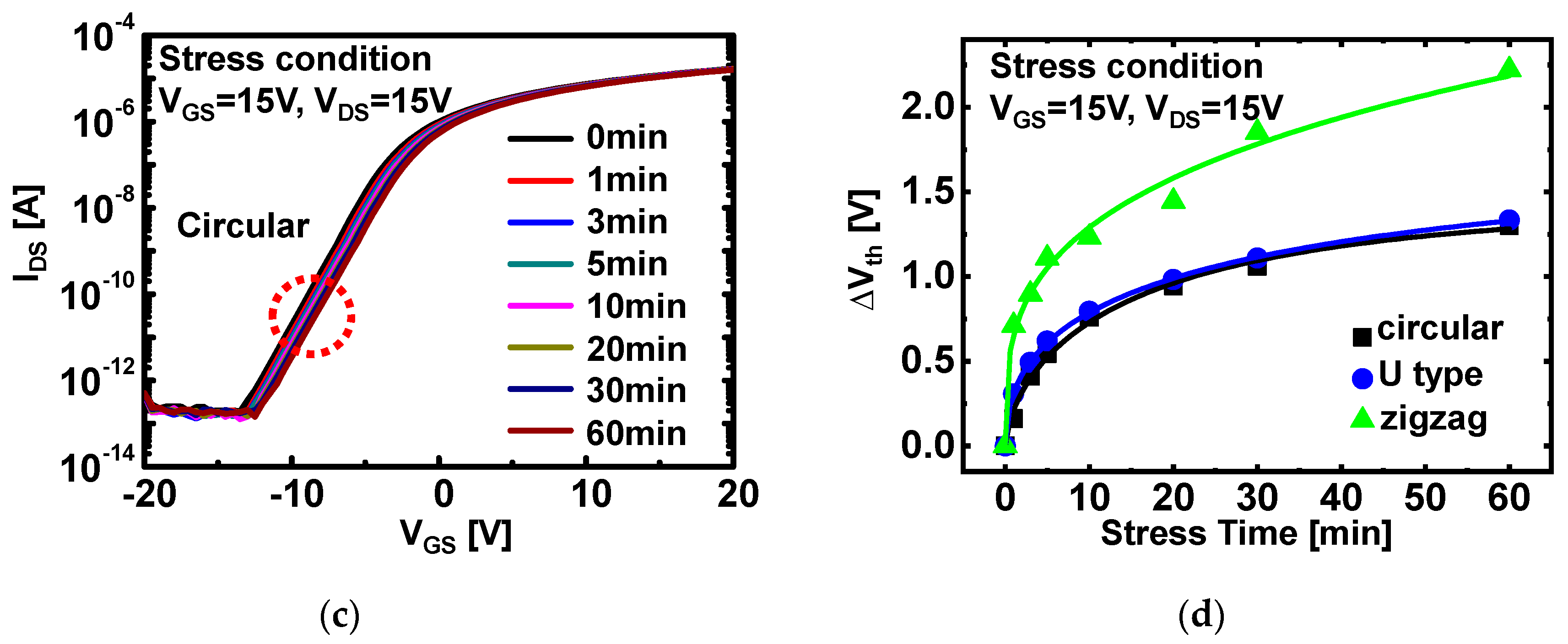
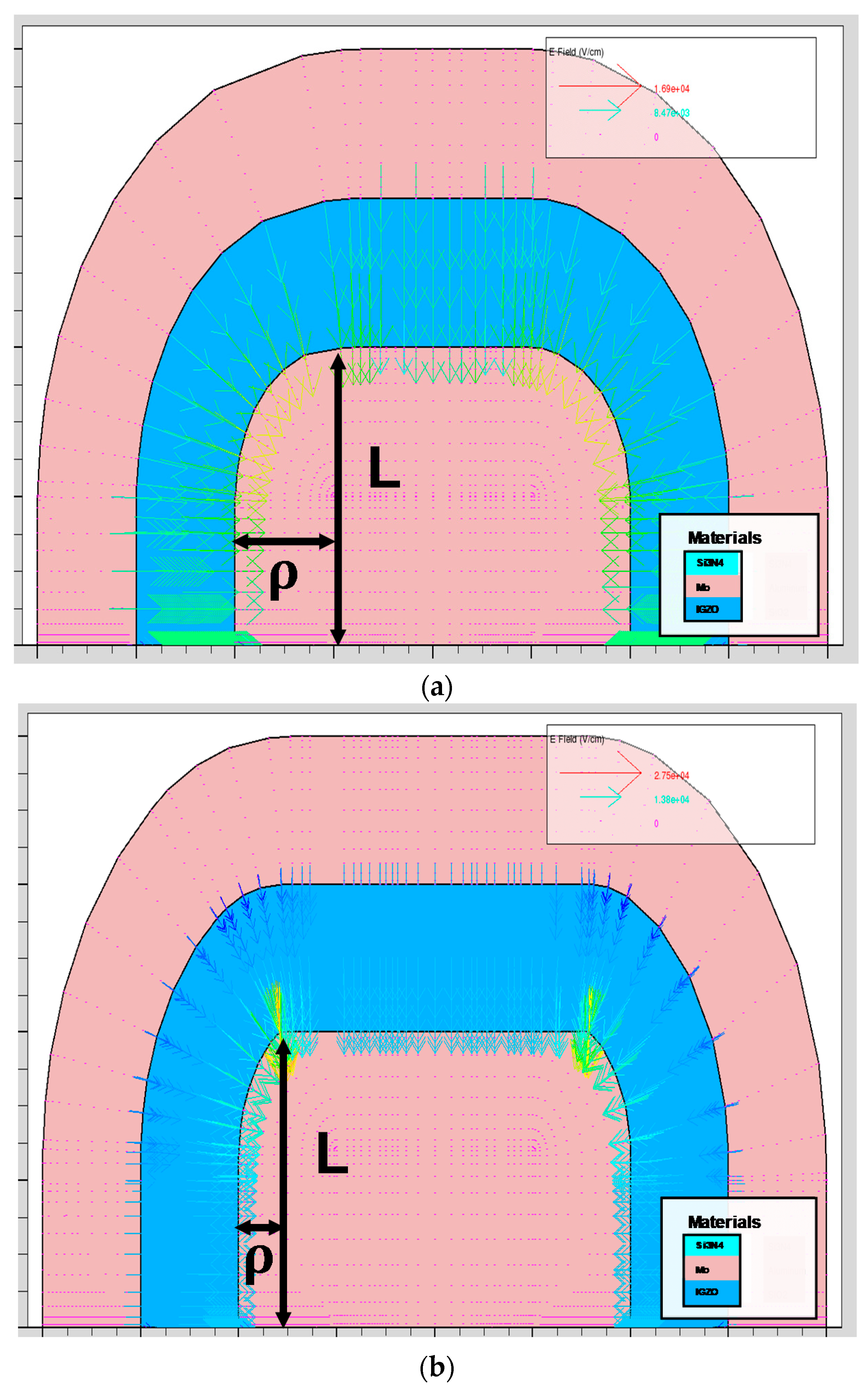

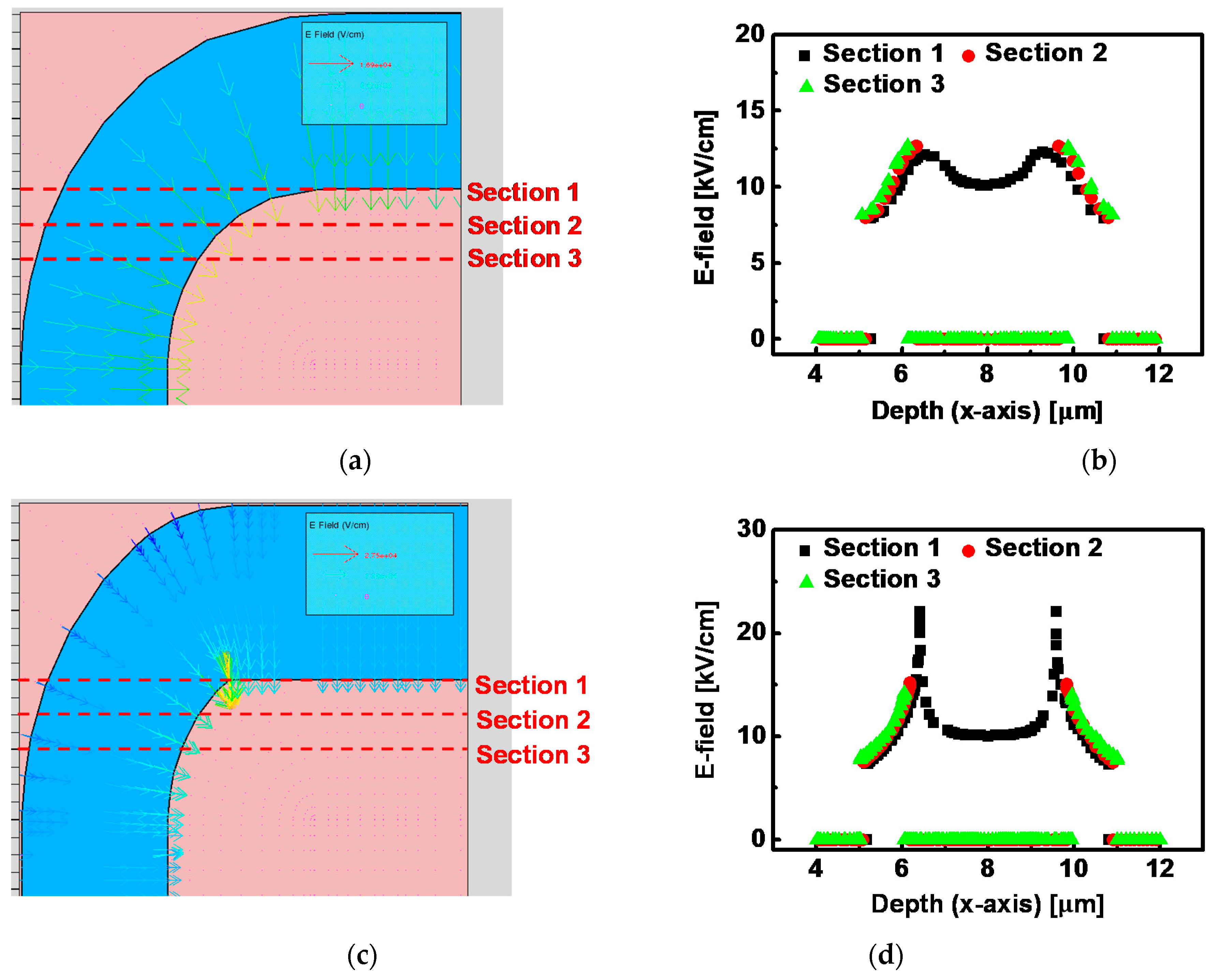
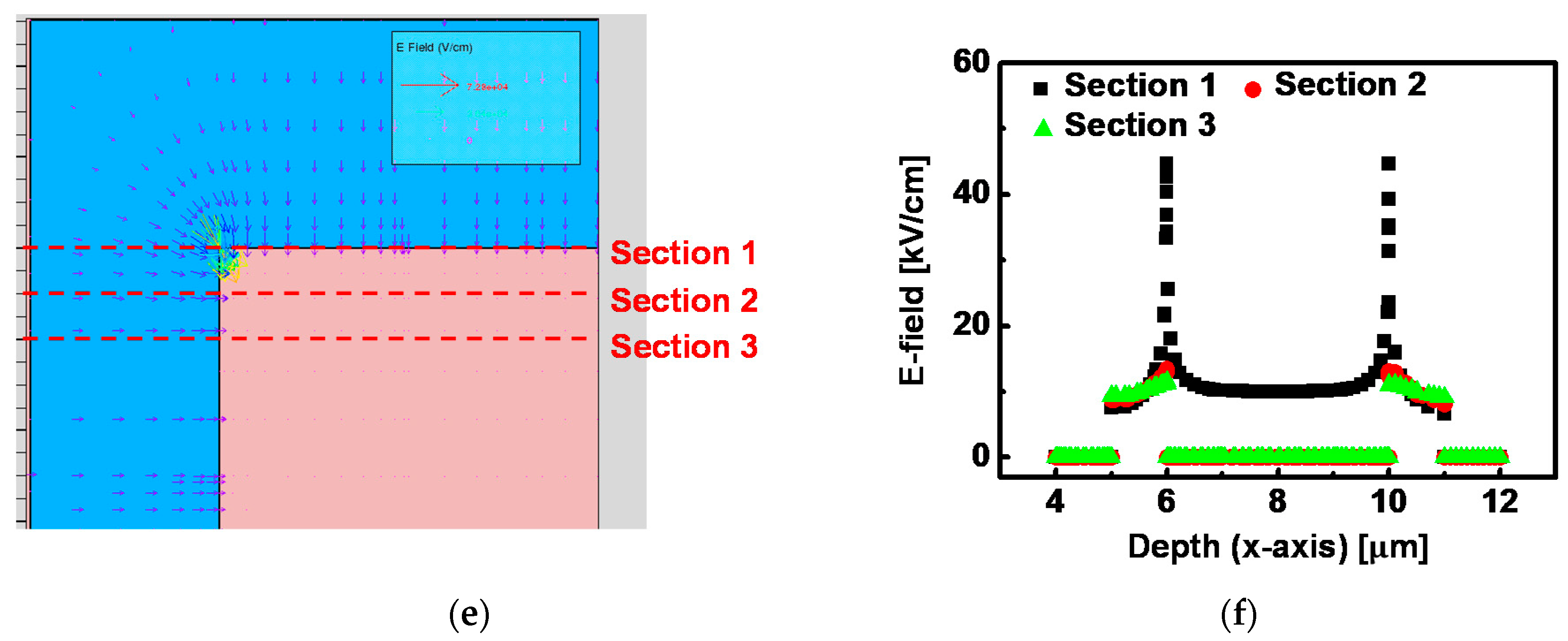

| Stress Condition | Parameter | Channel Shape | ||
|---|---|---|---|---|
| Circular | U-Type | Zigzag | ||
| VGS = 25 V, VDS = 0.1 V | ∆Vth,max (V) | 3.32 | 3.06 | 3.32 |
| Trapping time, τ (s) | 1.6 × 104 | 2.8 × 104 | 1.1 × 104 | |
| VGS = 15 V, VDS = 15 V | ∆Vth,max (V) | 1.40 | 1.42 | 2.10 |
| Trapping time, τ (s) | 2.0 × 105 | 3.4 × 105 | 5.5 × 104 | |
Publisher’s Note: MDPI stays neutral with regard to jurisdictional claims in published maps and institutional affiliations. |
© 2020 by the authors. Licensee MDPI, Basel, Switzerland. This article is an open access article distributed under the terms and conditions of the Creative Commons Attribution (CC BY) license (http://creativecommons.org/licenses/by/4.0/).
Share and Cite
Seo, S.G.; Yu, S.J.; Kim, S.Y.; Jeong, J.; Jin, S.H. Channel Shape Effects on Device Instability of Amorphous Indium–Gallium–Zinc Oxide Thin Film Transistors. Micromachines 2021, 12, 2. https://doi.org/10.3390/mi12010002
Seo SG, Yu SJ, Kim SY, Jeong J, Jin SH. Channel Shape Effects on Device Instability of Amorphous Indium–Gallium–Zinc Oxide Thin Film Transistors. Micromachines. 2021; 12(1):2. https://doi.org/10.3390/mi12010002
Chicago/Turabian StyleSeo, Seung Gi, Seung Jae Yu, Seung Yeob Kim, Jinheon Jeong, and Sung Hun Jin. 2021. "Channel Shape Effects on Device Instability of Amorphous Indium–Gallium–Zinc Oxide Thin Film Transistors" Micromachines 12, no. 1: 2. https://doi.org/10.3390/mi12010002
APA StyleSeo, S. G., Yu, S. J., Kim, S. Y., Jeong, J., & Jin, S. H. (2021). Channel Shape Effects on Device Instability of Amorphous Indium–Gallium–Zinc Oxide Thin Film Transistors. Micromachines, 12(1), 2. https://doi.org/10.3390/mi12010002





